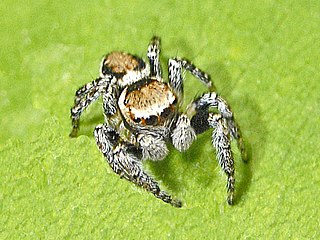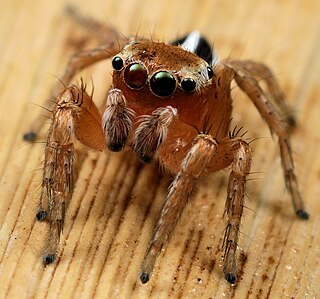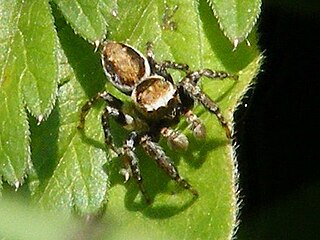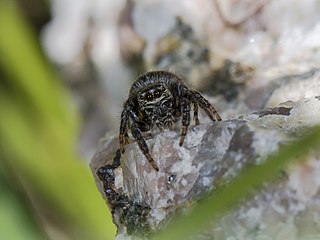
Evarcha is a genus of spiders in the family Salticidae with 85 species distributed across the world.

Evarcha falcata is a species of 'jumping spiders' belonging to the family Salticidae.

Evarcha arcuata is a species of jumping spiders with a palearctic distribution.

Evarcha vittula, the White-banded Evarcha Jumping Spider, is a species of jumping spider in the genus Evarcha that lives in South Africa. The species was first described in 2011 by Charles Haddad and Wanda Wesołowska. The spider is small, with a carapace measuring between 2.4 and 3.2 mm long and an abdomen between 2.5 and 3.6 mm long. There is a delicate scutum on the abdomen. The spider is generally dark brown but there is an orange streak down the middle of the upper surface of both the abdomen and carapace. This streak helps distinguish the spider from others in the genus. It can also be identified by its copulatory organs. The male has a characteristic short straight embolus. The female has not been described.

Evarcha brinki is a species of jumping spider in the genus Evarcha that lives in Northern Cape, South Africa. The species was first described in 2011 by Charles Haddad and Wanda Wesołowska. The spider is small, with a carapace measuring typically 2.5 mm (0.10 in) long and an abdomen 2.1 mm (0.08 in) long. It is generally yellow, with an orange tinge to the top of the carapace and a darker, nearly black eye field. There are large black spots on the abdomen. While the majority of the legs are yellow, the front pair are brown. It is very different to other African Evarcha spiders. Its copulatory organs are distinctive, particularly the male's embolus, which is short and encircled by a very thin appendage. The female has not been described.

Evarcha acuta is a species of jumping spider in the genus Evarcha that lives in Namibia, Seychelles and South Africa. The species was first described in 2006 by Wanda Wesołowska. The spider is small, with a carapace measuring typically 1.6 mm (0.06 in) long and an abdomen between 1.4 and 1.9 mm long. The carapace is light brown with a short black eye field. The abdomen has patterns that vary depending on geography. The holotype, found near Brandberg Mountain in Namibia, has lines of brown patches on the top. Examples found in Free State, South Africa, have black lines on the top and sides. The spider can be most easily distinguished from other spiders in the genus by its copulatory organs. The male has a distinctive notch on a long straight projection from its tibia known as a tibial apophysis and a long embolus. The female has not been described.

Evarcha aposto is a species of jumping spider in the genus Evarcha that lives in Ethiopia and Nigeria. The species was first described in 2008 by Wanda Wesołowska and Beata Tomasiewicz. It is named for the place in Ethiopia where it was first found. The spider is small, with a cephalothorax measuring between 1.9 and 2.2 mm long and an abdomen between 1.8 and 1.9 mm long. The carapace is generally light, yellow or fawn, with a dark stripe down the middle and occasionally a thin stripe to the rear. The abdomen is yellow with a pattern of darker patches. It has a black eye field. The front legs are darker, brown in the case of those found in Nigeria and black for the Ethiopian examples. The remaining legs have a distinctive top half that is black or brown, the remainder being yellow. Its copulatory organs are distinctive, particularly the male's very short embolus, which is accompanied by a spoon-like appendage. The female has not been described.

Evarcha awashi is a species of jumping spider in the genus Evarcha that lives in Ethiopia. The species was first described in 2008 by Wanda Wesołowska and Beata Tomasiewicz. The spider is small, with a cephalothorax measuring between 2.0 and 2.3 mm long and an abdomen between 1.9 and 2.4 mm long. The male and female are similar in size but differ slightly externally. The male carapace is orange while the female is brown, both with a darker eye field. The pattern on the abdomen is generally similar, a combination of light background and dark patches, but the female has less contrast between the two. The legs are mainly brown with yellowish tarsi. Its copulatory organs are distinctive. The male has a short embolus that follows the palpal bulb and a sharp tooth on its short wide and blunt protrusion on its palpal tibia, or tibial apophysis. The female has insemination ducts that narrow into multi-chambered spermathecae.

Evarcha pinguis is a species of jumping spider in the genus Evarcha that lives in Ethiopia. The species was first described in 2008 by Wanda Wesołowska and Beata Tomasiewicz. The spider is larger than others in the genus, with a cephalothorax measuring 3.4 mm (0.13 in) long and an abdomen between 4.7 mm (0.19 in) long. The spider is dark brown and hairy apart from a lighter streak on the back of the carapace and a pattern of light chevrons down the back of the abdomen. The legs are brown, the front four being thicker and shorter than the rest. The copulatory organs are distinctive. The female has marked sclerotization to the edge of its epigyne. The male has not been described.

Evarcha russellsmithi is a species of jumping spider in the genus Evarcha that lives in Ethiopia. The species was first described in 2008 by Wanda Wesołowska and Beata Tomasiewicz. The spider is small to medium-sized, with a cephalothorax measuring typically 2.2 mm (0.09 in) long and an abdomen 1.8 mm (0.07 in) long. The carapace is yellowish with dark rings around the spider's eyes. The abdomen is brown with an indistinct pattern of spots and lines. The legs are generally brown. The copulatory organs are distinctive. The male has a projection, or apophysis, from the palpal tibia that has a series of tooth-like features, and a very short embolus that is attached to another very small apophysis. The female has multi-chambered spermathecae and distinctive accessory glands.
Evarcha maculata is a species of jumping spider in the genus Evarcha that lives in Guinea, Ivory Coast and Ethiopia. It has been found in savanna in the Guinea Highlands and near bodies of water like the Awash River. The species was first described in 2002 by Christine Rollard and Wanda Wesołowska. The spider is small, with a cephalothorax measuring between 1.7 and 2.3 mm long and an abdomen that is between 1.6 and 3.6 mm long. The female is generally larger than the male, although there are exceptions, particularly amongst those found in Guinea. The cephalothorax has a yellowish topside, or carapace, with a darker eye field, and a yellow or yellowish-orange, or sternum. The abdomen has a distinctive pattern that is basically shaped like a capital "H", referred to in the species name, which can be translated "spotted". The spider has orange or yellow legs. It has distinctive copulatory organs. The female has distinctively shaped insemination ducts. The male has a very short curved embolus.

Evarcha striolata is a species of jumping spider in the genus Evarcha that lives in South Africa. The species was first described in 2009 by Wanda Wesołowska and Charles Haddad. The spider lives in savanna and forests. Medium-sized, the spider has a dark orange or yellowish-orange carapace, the top side of its cephalothorax, measuring between 2.1 and 2.6 mm in length and an abdomen that is between 2 and 2.5 mm long. The male has a pattern of dark stripes on the top of its abdomen, which is recalled in the species name. The female is generally lighter and has indistinct lines formed of dots on both the top and bottom of its abdomen. The underside of cephalothorax, or sternum, is dark yellow in both the female and male. It can be distinguished from other species in the genus by its copulatory organs, particularly the shape of the male's palpal bulb and the female spermathecae. These are also more similar to Asian and Australian spiders in the genus, which has led Jerzy Prószyński to suggest that it should be a member of a different genus named Evacin.

Evarcha karas is a species of jumping spider in the genus Evarcha that was first described in 2011 by Wanda Wesołowska. Originally only found in Namibia, it has also been discovered living in South Africa. It is a ground-dwelling spider that mainly lives in dry Nama Karoo shrublands. Only the male has been described. It is small, with an oval dark brown to black cephalothorax and a thinner ovoid abdomen that are each between 2.2 and 2.6 mm in length. The abdomen has thin white stripes along its middle and sides, which helps differentiate it from the related Evarcha flagellaris that also lives in the same area of the world. It can also be distinguished by its copulatory organs, including the long spike on its palpal tibia, or tibial apophysis, that has a tip with two points, and its very long thin embolus.

Evarcha grandis is a species of jumping spider in the genus Evarcha that lives in Nigeria. The species was first described in 2011 by Wanda Wesołowska and Anthony Russell-Smith. It is larger than typically for the genus, which is reflected in the species name derived from the Latin word that means "large". The spider has a cephalothorax that is typically 3.6 mm (0.14 in) long and an abdomen 5.7 mm (0.22 in) long. It has a brown carapace with a black eye field and greyish-brown abdomen. It has long brown bristles on its clypeus, or face, and white lines on its cheeks. The spider's legs are dark brown. Apart from its size, the spider's copulatory organs are the most clear way to identify it. The female has pockets towards the midpoint, rather than the rear, of its epigyne, short insemination ducts and large spermathecae. The male has not been described.

Evarcha arabica is a species of jumping spider in the genus Evarcha that lives in Yemen. The species was first described in 2007 by Wanda Wesołowska and Antonius van Harten. The spider is small, with a carapace that measures between 2.1 and 2.7 mm long and an abdomen that is between 1.8 and 3.2 mm long. The female is generally larger and lighter than the male. The spider's eye field is darker. The top of the male abdomen is blackish-brown with a pattern of white dots and a large yellowish-orange belt. The top of the female abdomen has similar white dots but is mainly yellow with small darker dots. The male's legs are brown and yellow while the female's are orange to yellow. It has distinctive copulatory organs. The female has accessory glands near the copulatory openings and simple bean-like spermathecae. The male has a thin embolus and a tibial apophysis that has a forked tip.

Evarcha picta is a species of jumping spider in the genus Evarcha that lives in Yemen. The species was first described in 2007 by Wanda Wesołowska and Antonius van Harten. The spider is small, with a carapace that measures between 2.4 and 2.6 mm long and an abdomen that is between 2 and 2.4 mm long. It has a distinctive pattern on its abdomen that is recalled in its name, which can be translated "patterned", which includes a series of white dots and chevrons. The pattern is less clear on the female than the male. Otherwise, the spider is generally brown and yellow. The male's legs are brown and yellow while the female's are yellow. There is a characteristic fovea, or indentation, in the centre of the carapace. It has distinctive copulatory organs. The female has a large depression in the centre of its epigyne and narrow insemination ducts that lead to long accessory glands and small spermathecae. The male has a terminal apophysis that makes it look as if its embolus has two branches. The spider's brownish-orange clypeus is also an identifying trait.

Evarcha seyun is a species of jumping spider in the genus Evarcha that is endemic to the Arabian Peninsula. It seems to be common across many of the Emirates of the United Arab Emirates and the Al Mahrah and Hadramaut Governorates of Yemen. The species was first described in 2007 by Wanda Wesołowska and Antonius van Harten. The spider is small, with a cephalothorax that measures between 2.2 and 2.6 mm long and an abdomen that is between 2 and 2.7 mm long. The female is hairier than the male. The female spider is generally brown with a darker eye field, while the male is dark brown with a black eye field. Both have legs that are black, orange and yellow. They can be distinguished from the closely-related Evarcha praeclara by the patterns on their body, including a semi-lunar marking in the middle of its carapace and a light stripe on its abdomen. The species also has distinctive copulatory organs. The female has a characteristic depression in the middle of its epigyne and narrow insemination ducts that lead to complex spermathecae. The male has a spade-like apophysis that accompanies its embolus and a short blunt tibial apophysis.

Evarcha praeclara is a species of jumping spider in the genus Evarcha that lives in Iran, Israel, South Sudan, Sudan, the United Arab Emirates and Yemen. The first examples of the spider were first identified by Eugène Simon in the early twentieth century in what is now Southern Sudan, but it was not until 2003 that the species was formally described by Jerzy Prószyński and Wanda Wesołowska. The exact nature of the species is disputed, with Prószyński stating that the examples found may be a group of species rather than a single one. Those that have been described are small, with a carapace that is between 2.1 and 2.4 mm long and an ovoid abdomen that measures between 1.7 and 3.2 mm long. The female is generally larger than the male. They have a brown or dark brown carapace, the female being plain while the male having a pattern of creamy white spots. The pattern on the top of the abdomen varies, with some spiders having lighter patches on a russet background and others being brown and white. They are all hairy. The spiders have generally brown mouthparts. The spiders' copulatory organs are distinctive and help distinguish the species from others in the genus. The female has an unusual trapezoid-shaped depression in its epigyne. The male has a broad embolus that has a tip that hugs a very distinctive protrusion, or apophysis.
Evarcha denticulata is a species of jumping spider in the genus Evarcha that is endemic to South Africa. It is ground-dwelling spider, thriving in the fynbos found in the Eastern Cape. The spider is small, with a rounded cephalothorax that is usually between 2.1 and 2.5 mm long and an ovoid abdomen that is between 1.8 and 3.4 mm long. The female has a larger abdomen than the male. It is also lighter, with a pattern of grey patches visible on its yellow background. The male is generally blackish-brown. Both have three lines of white hairs on the spider's cheeks. The male Evarcha denticulata has a distinctive tooth on the spike, or apophysis, that emanates from its palpal tibia, which is recalled in the specific name. The species was first described in 2013 by Wanda Wesołowska and Charles Hadded.

Evarcha michailovi is a species of jumping spider in the genus Evarcha that is endemic to Europe and Asia. It thrives in dry grassland and heath, but it has also been found in areas of human habitation. The species was first described in 1992 by Dmitri Logunov based on a specimen found in Russia. Examples of the species had been previously discovered in Mongolia ten years earlier, but these had been misidentified. The spider has a brown to dark brown carapace that measures between 2.08 and 2.75 mm in length that, in some examples, has light stripes running down its sides. Its black eye field is marked by a white stripe while its clypeus is orange and hairy. It has an abdomen that is between 1.88 and 3.13 mm long, the females are generally larger than males. It is often dark grey on top but there is a wide variation in the pattern across different specimens. The underside of the abdomen is a uniform brown-grey, The markings on the carapace help distinguish the species from others in the genus, as does the species distribution. It can also be identified by its copulatory organs, particularly the shape of the male embolus and the presence of a plate on the female epigyne.















